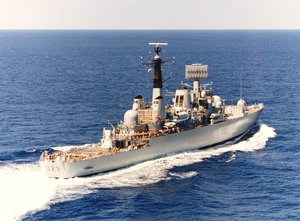HMS Bristol (D23)
|
|

| |
| Career | 
|
|---|---|
| Ordered: | |
| Laid down: | 15 November 1967 |
| Launched: | 30 June 1969 |
| Commissioned: | 31 March 1973 |
| Decommissioned: | 1987 |
| Fate: | |
| Struck: | |
| General Characteristics | |
| Displacement: | 6,000 tons |
| Length: | 507 feet |
| Beam: | 55 feet |
| Draught: | |
| Propulsion: | COSAG (Combination of Steam and Gas) turbines, 2 shafts |
| Speed: | |
| Range: | |
| Complement: | 407 |
| Armament: | Sea Dart, Ikara, 4.5" gun, Depth charge mortar. |
| Aircraft: | |
| Motto: | |
HMS Bristol (D23) was the only Type 82 destroyer of the Royal Navy.
Originally intended as the first of a class of new large destroyers to escort the CVA-01 aircraft carriers projected to come into service in the early 1970s, Bristol turned out to be a unique ship. The rest of the class were cancelled when the CVA-01 carriers fell victim to the 1966 Strategic Defence Review.
Bristol saw a number of new systems introduced into the Navy, including the Sea Dart and Ikara missile systems, which remains in service on board the Type 42 destroyers of the fleet in the early 21st century.
Bristol had a relatively long Navy career that included service in the Falklands War, where ships with the Sea Dart system were desperately needed. However, as the 1990s dawned, the ship was increasingly becoming an anachronism. As the fleet downsized, maintaining a unique vessel over 20 years old when plenty of other AAW destroyers were in commission no longer seemed worthwhile. Bristol was therefore decommissioned in 1987 and refitted to replace the County-class destroyer Kent as a cadet training ship.
Bristol recommissioned in this role in September 1987 and in 1993 she underwent another refit, again to replace Kent, but this time as a static training ship at Dartmouth. Bristol remains in this role today, but with all armament and sensors removed.
HMS Bristol is permanently berthed at the training establishment HMS Excellent, on Whale Island, Portsmouth.
See HMS Bristol for other ships of the same name.
